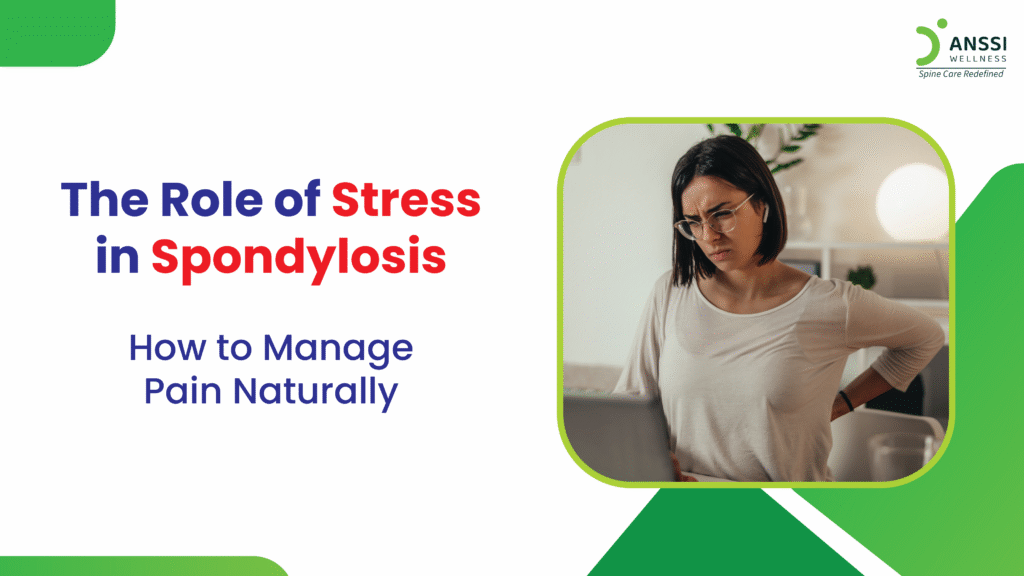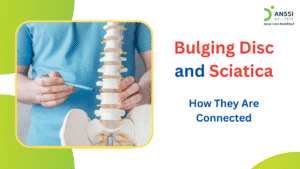Spondylosis, a common age-related degeneration of the spine, affects millions worldwide. It can impact the cervical (neck), thoracic (mid-back), or lumbar (lower back) regions, causing pain, stiffness, and restricted movement. While the physical wear and tear of the spine is the primary cause, many are unaware of the critical role emotional and psychological stress plays in worsening symptoms.
Understanding this connection and adopting natural ways to manage stress can significantly ease spondylosis-related pain.
Understanding the Stress–Pain Connection
The relationship between stress and pain is well-documented in medical research. When a person is stressed, the body enters a “fight or flight” mode, releasing stress hormones like cortisol and adrenaline. This physiological response can lead to muscle tension, increased inflammation, and a heightened sensitivity to pain, all of which contribute to worsening spondylosis symptoms.
Muscle tightness in the back and neck is a common physical response to stress. Over time, this can lead to reduced flexibility, poor posture, and additional strain on already-degenerating spinal discs and joints. Furthermore, stress impairs the body’s natural healing processes, which can slow recovery from inflammation and injury in spinal tissues.
Common Stress Triggers in Spondylosis Patients
People suffering from spondylosis often experience a loop of physical discomfort and psychological stress. This cycle can become a long-term issue if not addressed holistically.
Common stress triggers include:
- Sedentary lifestyle: Office-based jobs or long hours of inactivity can increase spinal stiffness and promote poor posture.
- Work pressure: High mental load and deadlines can induce tension in the neck and shoulders.
- Poor sleep: Pain can disrupt sleep, and lack of rest further intensifies pain sensitivity.
- Fear of movement: People with chronic pain may avoid physical activity, fearing it will worsen their condition, which ironically leads to further joint stiffness and muscle weakening.
Addressing these stressors through both mindset and lifestyle changes can break the pain-stress cycle.
Natural Pain Management Techniques
The good news is that stress-induced spondylosis pain can often be managed naturally through simple, consistent strategies. Here are some highly effective non-medication-based methods:
1. Mindfulness, Deep Breathing and Meditation
Relaxation techniques help calm the nervous system. Deep breathing slows the heart rate and reduces cortisol levels, relieving muscle tension and calming the mind. Even 10 minutes of guided meditation a day can improve pain tolerance and reduce anxiety.
2. Yoga and Gentle Stretching
Practices like yoga not only promote physical flexibility but also mental calmness. Yoga postures targeted at spinal mobility, core strength, and breathing can ease spinal compression and enhance alignment. Poses like Child’s Pose, Cat-Cow, and gentle spinal twists are particularly beneficial.
3. Low-Impact Exercise
Walking, swimming, or cycling increases blood flow, boosts endorphins (natural painkillers), and maintains joint mobility without putting pressure on the spine. Regular movement prevents stiffness and helps manage weight, another contributor to back pain.
4. Hot and Cold Therapy
Applying a warm compress helps increase blood flow and relax stiff muscles. On the other hand, cold packs reduce inflammation and numb pain. Alternating between hot and cold therapy can be highly effective in reducing spondylosis discomfort.
5. Anti-Inflammatory Diet
Chronic inflammation can worsen spondylosis symptoms. Incorporating anti-inflammatory foods like turmeric, ginger, fatty fish (rich in omega-3s), leafy greens, nuts, and berries can help. Reducing sugar, processed foods, and refined carbs is also essential.
6. Postural Awareness and Ergonomics
Poor posture can strain the spine and aggravate symptoms. Making small changes like using lumbar support, adjusting screen height, or taking regular breaks from sitting can improve spinal alignment. Practising correct posture while walking, sitting, or lifting objects also reduces unnecessary strain.
Being Cautious of Worsening pain
While natural methods offer significant relief, it’s important to consult a medical expert if pain persists or worsens. A comprehensive evaluation can help rule out other spinal conditions and guide you to the most appropriate treatment.
Non-surgical treatment options like non-surgical spinal decompression treatment, which is a non-invasive, drug-free solution, can provide lasting relief by gently stretching the spine and relieving pressure on affected discs and nerves. Paired with physiotherapy, spinal decompression can improve function and reduce dependence on medications or surgery.
Additionally, stress management counselling, physiotherapy for posture correction, or ergonomic assessments can offer personalised solutions based on your lifestyle and condition.
About ANSSI:
ANSSI Wellness focuses on improving the quality of life for patients suffering from spinal issues, aiming to provide relief where other conventional treatments have failed. Through advanced non-surgical spinal decompression treatment, ANSSI is committed to helping patients avoid surgery and recover in a safe, effective, and compassionate environment.
Connect with ANSSI Wellness on LinkedIn, Instagram, and Facebook for expert guidance.



